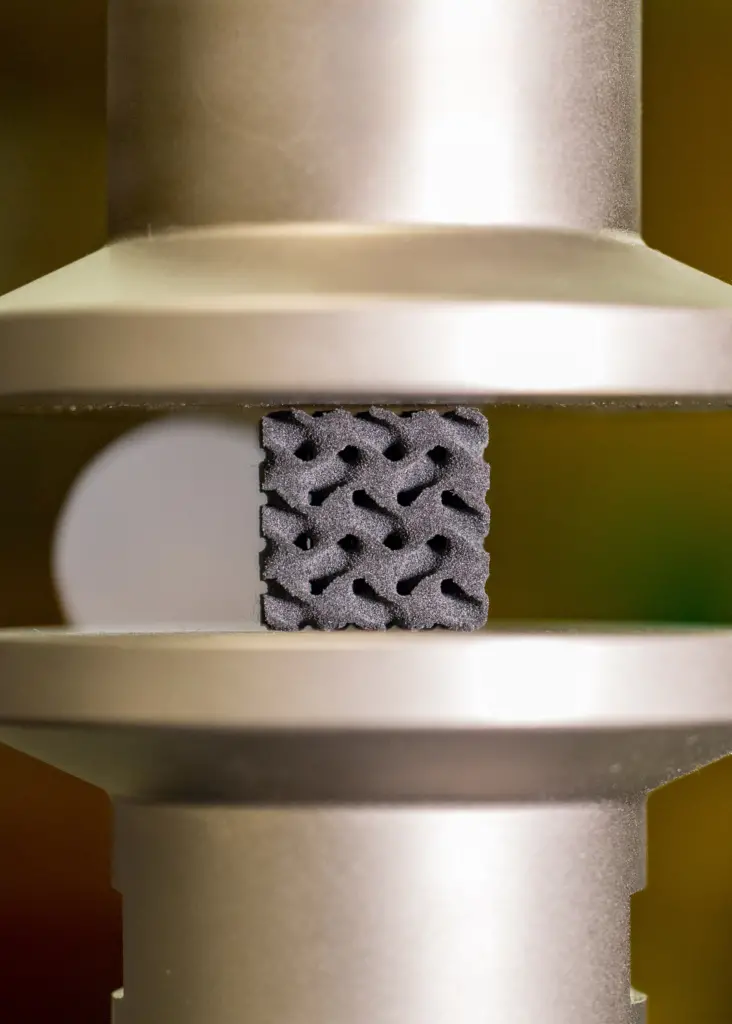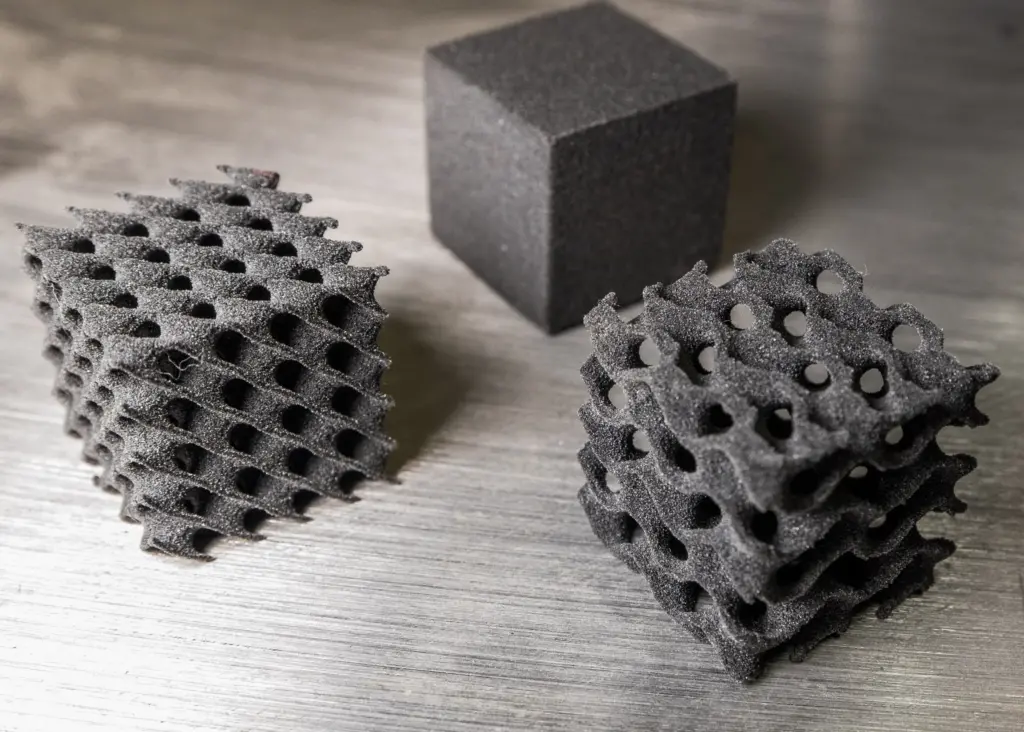It might put an extra bounce in your step or add resilience to the hull of a ship: The unique internal structure of a lightweight 3D-printed syntactic foam created by University of Wisconsin-Madison engineers allows it to absorb a blow, then spring right back to its original shape.
Pavana Prabhakar, the Charles G. Salmon associate professor of mechanical engineering and civil and environmental engineering, and PhD student Hridyesh Tewani designed the new foam. Its key feature: “embedded multilevel architectures,” which build upon the tiny structures already present within syntactic foams. Syntactic foams are composites made up of tiny hollow spheres called “microballoons.”These microballoons, which can be made of different materials like polymer or glass, give syntactic foams high strength relative to their low density, when integrated into a flexible polymer.
 A sample of the architected foam, which can take the force of a compression and return to its original shape thanks to multilevel embedded architectures.
A sample of the architected foam, which can take the force of a compression and return to its original shape thanks to multilevel embedded architectures.
Then Prabhakar and Tewani tinkered with the structure even further, essentially creating an architecture around an architecture—using the microballoons as a guide to create larger, millimeter-scale gaps in the material. They described the new foam material in a paper published in the journal Composites Part B: Engineering in February 2024.
“We want to reduce weight, and a way to do that is to create higher-level hollow regions in the material,” Prabhakar says.
Designing a material in this way could open opportunities for new lightweight, resilient materials with a wide range of potential applications. Tewani says the multilevel architecture—larger specific designed voids with smaller microballoon-sized voids already in the base material—create a “bounce-back” foam, which means it can take the force of an impact and return to its original shape. This builds upon some of Prabhakar’s prior research in the field.
That ability to take repeated impacts and bounce back to form means that applications for these materials could include many ways to protect an object from collisions—for example, a player’s head inside an athletic helmet. Prabhakar says she and Tewani also envision the foams sandwiched between stiffer plates—such as in the hull of an airplane—during research. Her research group is also studying how moisture impacts the durability of architected syntactic foams in such use cases.
“Let’s say we have a bird strike with an airplane, or that you have a marine vessel that is going to have repeated ice sheet impacts in the Arctic,” Prabhakar says. “We want the material to be able to absorb that energy and also return to its original shape. There are multi-use purposes for these architectures that we’re developing—not just one time and done.”
 Associate Professor Pavana Prabhakar and PhD student Hridyesh Tewani have created a process to build architected foams with complex architectures based on the smaller hollows present within the material. The material is 3D printed, allowing for different architectures that give it different properties. Credit: Joel Hallberg.
Associate Professor Pavana Prabhakar and PhD student Hridyesh Tewani have created a process to build architected foams with complex architectures based on the smaller hollows present within the material. The material is 3D printed, allowing for different architectures that give it different properties. Credit: Joel Hallberg.
These architected foams could have many uses beyond highly specialized or intensive purposes. Because the foams are created using 3D printing, also known as additive manufacturing, they’re incredibly customizable.
Prabhakar and Tewani also found during their research that the particle size and content used to manipulate the microstructures impact the foam material’s performance—so adjusting the parameters of both additive manufacturing and microballoons allows them to precisely adjust the material’s microstructure. Those microscale tweaks ripple up to the macro level and can be the difference between a material capable of compressing with the force of an impact, or one that’s much stiffer.
“If you bring in different levels of architecture within the material, you can fine-tune the mechanical responses,” Tewani says. “That gives you more freedom to design objects for different uses. So maybe one type of design in one material is good for a helmet liner, and another one is good for a ship, and an entirely different one might be good for shoe soles.”
Prabhakar and Tewani are patenting their work through the Wisconsin Alumni Research Foundation.
This research was partly funded by the U.S. Department of Defense (DoD) Office of Naval Research – Young Investigator Program (ONR – YIP) Grant [N00014-19-1-2206] through the Sea-based Aviation: Structures and Materials Program.
Featured image caption: Associate Professor Pavana Prabhakar, left, and PhD student Hridyesh Tewani prepare a sample of their architected foam material for testing. All photos by Joel Hallberg.